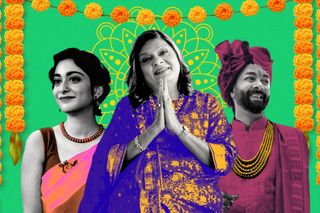
How Matrimonial Shows Like ‘Indian Matchmaking’ Use a Western Gaze for Popularity
Over the last few years, Indian-origin filmmakers have exoticized and dumbed-down Indian weddings to make them palatable for a global streaming audience.

“In India, we don’t say arranged marriage. There is marriage and love marriage,” says “Mumbai’s top matchmaker” Sima Taparia of Indian Matchmaking (2020). The popular Netflix reality show – which returned to screens on April 21, 2023 for a third season – casts Taparia as a flag-bearer for a hidebound community. Better known as Sima Aunty, the matchmaker – now a viral meme – glosses over casteism, expounds superstitious beliefs around marriage, and normalizes fatphobic and classist marital preferences through catchphrases like “slim, trim, and educated.”
The reality showthus joins a string of recent releases that self-exocitize India’s arranged marriage traditions without contextualizing or critiquing them.
Despite touting itself as a docu-series, Indian Matchmaking seems to be self-aware of its insincerity and invites viewers to revel in the ridicule of Taparia’s matchmaking chops. The camera often zooms in on her disapproving and taken-aback looks at the long checklists for partner preferences her clients present her with. The light, quirky background score further underlines the tongue-in-cheek tone. While appearing to demystify an important cultural institution, the seriesends up casting Indian arranged marriage as a benighted tradition, with baked-in, age-old customs like horoscope-matching and face-reading.
Given its significant reception in the US and around the world, the lack of variety and rigor in the show’s projection of Indian matrimony has the danger of amplifying pre-existing bias and of coloring the view of Western viewers lacking context. Over the last few years, Indian-origin filmmakers have similarly exoticized and dumbed-down the institution to make it palatable for a global streaming audience. These filmmakers, often world-renowned like Mira Nair and Indian Matchmaking’s Smriti Mundhra, are unwittingly delineating the global threshold for accepting these aspects of Indian culture. Their hackneyed Orientalist tropes reify South Asian stereotypes such as the model minority myth, colourism, casteism, classism, and sexism – without offering new perspectives or constructive criticism.
The creators, many of whom are Indian-American, are often driven by the need to justify their motherland’s questionable customs. “I didn’t want to sanitize it and shy away from those difficult conversations,” said Mundhra, who was inspired by her own negative experiences of the matchmaking process. But so far, these uni-dimensional projects have been missed opportunities for insightful commentary on the centuries-old custom. A passing mention of how grooms prefer fair-skinned brides or the lack of willingness to talk about caste because it is “implicit” defeats Mundhra’s impetus of “telling it as it is.”
In exaggerating certain aspects of the matchmaking tradition – such as the use of biodatas, the practices of horoscope matching and face reading, and intergenerational differences between Sima Aunty and her young clients – and ignoring others, recent OTT releases on Indian matrimonyundermine the dark underbelly of the country’s arranged marriage institution. This includes the coded practices of casteism and dowry, legitimacy of marital rape, domestic abuse, and the transnational abandonment of women. But these shows also neglect the positive evolution of the industry, such as digital innovations, reduced parental interference, and the growing agency of younger generations in choosing their partners. Moreover, the spate’s singular focus on heteronormative, upper-class, upper-caste Hindus and Non-Resident Indians has allowed a privileged, homogenous group to define culture for a country as diverse as India.
Related on The Swaddle:
The Ironic Appreciation of ‘Indian Matchmaking’ Signals an Ideological Blind Spot
In 2021, Condé Nast India produced The Big Day, another reality series that aimed to give viewers a glimpse into India’s multi-billion dollar wedding industry but only ended up showing selective scenes of grandeur from the country’s one-percenters. “I feel like I inhabited a Bollywood movie in real life,” says a White wedding guest in the first episode, setting the tone for the rest of the series. Even within the parameters that the show sets for itself – showing the wedding planning processes of India’s wealthy – it fails. It omits the arduous and tense coordination between the bride and groom’s families required to produce these extravagant weddings or the modern-day version of dowry encrypted in exorbitant gifts from the bride’s family to the groom’s. The Big Day rests one of its biggest claims to modernity in the episode featuring the wedding of a (rich) gay couple, but fails to explain the precarious legal context of the LGBTQ community in the country or even clarify that same-sex marriage is still illegal in India.
Film critic and director of New York Indian Film Festival, Aseem Chhabra, pegs these reality shows’ disingenuousness to the logistical reality of the streaming industry. “For a Netflix show that has to appeal across the board in different countries to go into class and especially caste can be very, very complicated,” he says. “It’s easier for people to just watch a show about rich people getting married as opposed to something like Made in Heaven.”
Chhabra is referring to Amazon Prime Video’s 2019 fictional series that takes viewers behind the scenes of South Delhi’s affluent weddings. The drama unpacks many systemic issues with matchmaking in modern-day India, from spotlighting private detective agencies specializing in pre-marital investigations to the superficial progressivism of upper-class mothers-in-law, the practices of dowry, caste discrimination, the struggles of LGBTQIA, and closeted male chauvinism. Notwithstanding certain creative liberties, Made in Heaven is the only release in recent years that captures the nuanced texture of Indian society’s matchmaking and wedding practices.
Other titles, like the BBC adaptation of Vikram Seth’s epic novel A Suitable Boy (2020)and Netflix’s romcom Wedding Season (2022) also take place in a fictional universe but are shot through the haze of a Western lens. The former is a sepia-toned saga of interfaith relationships and the charades of upper-class Indians (who speak English in exaggerated accents) and their matrimony customs, set against the nostalgic backdrop of a 1950s India. One of the central threads of the series follows Rupa Mehra, a single mother bent on finding “a suitable boy” for her 19-year-old daughter, Lata. Like Sima Aunty, Rupa is portrayed in a comedic light, jibing at Lata from time to time for the latter’s disdain against marriage. Her character furthers the cliché of Indian mothers looking with unswerving resolution to wed their children. Aseem Chhabra calls the show “Indian Jane Austen,” and the show’s Indian-American director Mira Nair terms it “The Crown’ in Brown,” hinting at its primary targeting of British audiences. In fact, the Oscar-nominated Nair is infamous among postcolonial scholars for exoticizing Indian customs and traditions for a Western audience in her star-studded films that deal with diaspora.
Related on The Swaddle:
Shaadi.com Removes Skin Tone Search Filter. But What About All the Other Offensive Filters?
On the other end of the spectrum is the 2022 Netflix rom-com Wedding Season, made by American director Tom Dey, LA-based Indian producer Swati Shetty, and Indian-American screenwriter Shiwani Srivastava. Like Indian Matchmaking’s Smriti Mundhra, Srivastava also sought to unpack Indian arranged marriage for an overseas audience.But her film ends up framing the institution as a regressive convention that the Indian-American female lead, Asha, must defeat in order to further her career and find love. It posits Asha’s Western worldview of free love as superior to the forceful and orthodox arranged marriage expectations of her parents. Wedding Season uses Asha’s Indian roots – gossiping aunties and an overbearing mother anxiously prompting her to lock down an Indian suitor – as a looming threat to her authentic self. Thus, Asha’s character champions a Western way of being against the backward Indian customs.
Wedding Season belongs to the category of NRI stories that assume that there’s one (loud, gaudy, conservative) way of being Indian and that this lifestyle holds back the protagonist rather than giving them momentum. Made in Heaven is again a good example here of what it would look like to invert this worn-out storytelling formula. It looks inwards to explore the teeming conflict within Indian matrimonial culture, rather than flattening and pitting the institution against a Western way of life. The show unapologetically lays bare the good, the bad, and the ugly behind modern Indian weddings. Its no-holds-barred representation gives us a bold, contemporary bride unafraid to walk away from an ill-intentioned union but also shows the continued stronghold of dowry in certain upper-class communities and the pressure it creates for the bride’s parents who often incur debt to get their daughter married – all in the same sub-plot. Directors Zoya Akhtar and Reema Kagti’s thrilling, dynamic and intimate portrayal of the undercurrent of North Indian nuptials, free of clichés or judgment, ensures that viewers are constantly amazed at and appalled by the sociopolitical realities it mirrors.
There’s been an audible buzz in the global mediascape about how South Asian stories are finally being seen and heard in popular culture. The makers of Wedding Season, Indian Matchmaking, and A Suitable Boy too have enjoyed such trophies from the press for giving their community a global platform. But the publicity around on-screen representation often clouds the much-needed critical discourse on their messaging. In bargaining for visibility and a platform, these filmmakers are offering up a deep, nuanced part of their culture as light-natured entertainment. In doing so, they fail to follow through with the complex stories they started, instead relying heavily on caricatures, tired narratives, and stereotypes.
It’s easier for global audiences to accept American reality shows like The Bachelor and Love Is Blind purely for their entertainment value because Hollywood has counterparts that highlight the messiness of Western romance like Modern Love or Marriage Story. But India’s layered stories are often reserved for the Indian audience, as to not confound or overwhelm outside viewers. The compromise is the same romanticized trope being nominated time and again as the trumpet for a historically underrepresented community.
Most of all, these clips are missed opportunities to document the sheer abundance of the evolving matrimonial traditions in the country. The ongoing battle to recognise same-sex marriage, the tyranny of caste politics despite the institution’s decades-old abolition, the slow but effective pushback against colourism by South Asian women, the emergence of AI-powered matrimony apps and the concurrent rise of matrimonial fraud are amongst other modern phenomena that are ignored. In the end, our culture is much more interesting than Netflix lets on.
Mihika is a New York-based cultural journalist who likes to write about the South Asian diaspora, identity, mental health, digital culture, human rights, and film and TV, among other things. Currently, she is currently pursuing an M.A. in Arts and Culture program at Columbia University's Graduate School of Journalism. Previously, she served as the Junior Digital Features Editor at Vogue India.
Related


The Rise of the ‘Sober‑Curious Movement,’ Explained
